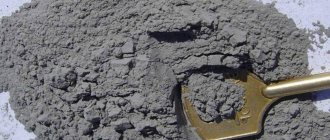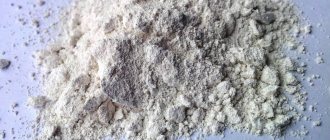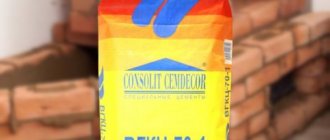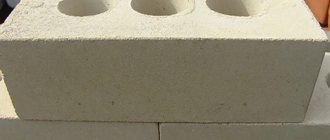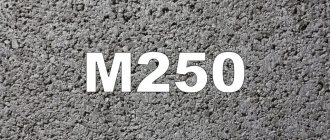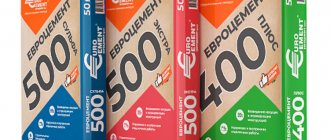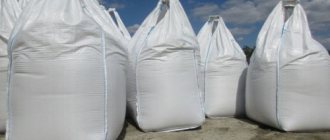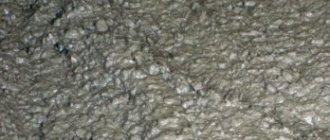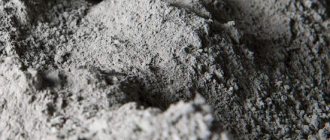The main component of the material is low-iron clinker, to which kaolin, crushed gypsum, crushed limestone, and chloric salt are added in certain proportions and sequence.
According to the degree of whiteness (reflection coefficient), the material is divided into three grades:
- First grade (highest) - from 80 to 85%;
- Second grade — 75%;
- Third grade — 68%.
Belonging to a particular variety and the degree of whiteness are indicated on the packaging. It is these characteristics that determine the areas of application, the price of the material and the appearance of products made using cement.
Today in construction stores you can buy Turkish white cement M600 labeled “Super White” and with a reflectivity of 90%. The price of a 50 kg bag is on average 700-800 rubles (prices are current for spring 2022)..
How to make the solution yourself
White cement itself, diluted with water, is not used in construction, since the laid layer will very soon crack. This means you need to prepare a solution with filler.
The problem is that ordinary sand is not suitable for making white mortar.
Even sifted sand may contain a small amount of clay impurities that will color the solution. To use it at home successfully, you need a special filler. [td]Illustrations
| Description of the filler | |
| Industrially purified quartz sand . The grains of this filler are uniform in shape with a fraction of 0.1 to 1 mm. The color of the backfill ranges from translucent whitish, as in the photo, to light gray. | |
| River washed and seeded sand . Washed sand does not contain clay inclusions, and therefore the solution will be slightly colored. Backfill fraction is from 0.5 to 2 mm. | |
| Marble flour . The price of such a filler is higher than the cost of sand, but the finished solution will be truly white. The grinding fineness of the backfill is from 0.1 to 1.5 mm. |
In order not to make a mistake with the choice of filler, you can take several types of filler in small quantities for testing. Next, you need to prepare several test solutions with your own hands according to the number of test fills. A decision on the choice of filler must be made after the solutions have dried, when the degree of their whiteness can be assessed.
| Illustrations | Recommendations for preparing mortars |
| Proportions. The ratio of the components of the solution is the same as when working with gray cement: 1:3 - masonry mortar or white concrete for self-leveling floors; 1:5 - leveling plaster solution. The water-cement ratio should not exceed 0.4, that is, the solution should be dense, but well mixed. | |
| Preparation of building concrete. To prepare white concrete, the following proportions are used: 1 part cement, 3 parts sand and 2-3 parts coarse filler. If concrete is made to fill a floor, marble chips with a fraction of 10-15 mm are used as a filler. After the concrete gains grade strength, the surface is ground to perfect smoothness.
|
Scope of application
| Illustrations | Application of white cement |
| 1. Production of joint grout . Due to its high strength, white cement is used to make joint grout. Crushed chalk or gypsum is used as a filler in grout. The setting speed of the composition depends on the type of filler. | |
| 2. Production of mixtures for masonry mortars . To make clean decorative masonry look more attractive, a composition prepared on the basis of white cement is used as a solution. In terms of consistency, the masonry mortar is the same as ordinary masonry mortars, the only difference is the color. | |
| 3. Production of reinforced concrete products . White cement is used for stair treads, railings, decorative elements, tiles and various architectural forms. | |
| 4. Production of paving slabs and related elements . Paving slabs, curbs, concrete rings for joining trees, etc. are made from cement-sand mortar. Such products are either completely white or painted with special dyes. | |
| 5. Production of finishing bricks . Finishing brick is a type of facing tile that is used for wall cladding. The tiles are made from a mortar prepared on the basis of white cement, without dyes or with the addition of pigment powders. | |
| 6. Preparation of solutions for self-leveling floors . Dry mixtures are made from white cement with the addition of polymer fillers. After mixing with water, marble chips or other decorative fillers are added to the mixture. The solution is spread evenly over the floor surface, and after drying it is sanded and polished. | |
| 7. Preparation of solutions for external finishing . White cement is used for the production of dry plaster mixtures. The advantage of such mixtures over gypsum-based interior ones is their higher strength and weather resistance. | |
| 8. Making decorative sculptures . Cast sculptures are made from white cement for outdoor use. Such sculptures, unlike their plaster counterparts, last for at least ten years. |
About the use of white color and its importance
Despite the fact that brickwork even by itself looks quite presentable, almost 15% of the brick wall will be occupied by stripes - seams between the elements.
The classic version of brickwork has a dark red color and a white seam, which visually separates the elements from each other. Thanks to this combination of colors, the entire structure will be perceived completely differently - details, volume, shadows and texture of materials will be visible. Types of grout.
If you choose the wrong color for the seams, then the masonry will lose its appearance, become faded and inexpressive, and the appearance of the building will fade. Over time, under the influence of external factors and weather, the seam will turn gray, after which it will lose its attractiveness. The gray seam practically does not separate the elements, so the feeling of volume and expressiveness of forms disappears. This is how only 15% of the masonry area can affect the visual perception of the entire structure. It is worth remembering that attention to small details helps improve the perception of many buildings.
Fortunately, you can avoid all of these unwanted faded visual effects by choosing the right seam materials.
The meaning of color scheme in a brick wall
To enhance the decorative effect, a white masonry seam is used. With its help, the texture, color, and material of the stone are emphasized. It highlights every element and makes a dark brick house more presentable. The expressiveness of the texture is emphasized by the shadow of the seam. The combination with red in construction has always been considered classic. A gray or black seam harmonizes with the elements and does not visually highlight brown or other dark building material. At the same time, the brick facade looks dull.
It is important to consider that light-colored seams quickly get dirty and turn gray. For visual effect, it needs to be updated regularly.
Red, brown and black bricks are highlighted in white. A similar effect is mainly used for exterior decoration, but is also found in interior decoration of rooms with a brick wall. When building a fireplace with this combination, you should remember that a light shade is inappropriate and its possible premature contamination. It is enough to apply a solution of such a color that the surface of the building looks unusual without the use of mosaics or sculptures. During construction, light seams are found in the masonry:
This stitching pattern decorates a brick fence.
- non-residential objects (for example, courtyard buildings);
- columns and other architectural structures.
- fences;
- private houses;
How to create a white seam?
If you want to decorate your dark brick home with white joints, choose your additives very carefully. Also, the classic version of a pure white seam can be made using the following methods:
- The space between the bricks is grouted with special grouts that give the material color. It will not be possible to create a snow-white seam.
- The brick structure is treated with special compounds that help the materials develop color. The same composition has excellent protective properties and protects the wall from wear.
- When constructing a brick structure, a mortar with an appropriate shade of color, for example, white, is used. Jointing and contouring help achieve purity in the color of joints in brickwork.
In order for the solution to turn white, you need to add slaked lime.
White color helps to emphasize the volume and texture of the structure, thanks to it it is possible to highlight the details and individual elements of the wall, which is why it is used so often with red, orange and brown brick.
You can get it in the following ways using a standard masonry solution:
- add more slaked lime;
- use nitric oxide in the composition;
- get titanium oxide.
Unfortunately, each option is costly in its own way.
Production Aspects
The original cement with a high whiteness index has a special structure. Manufacturers obtain it by introducing a progressive methodology into the production process, which is formed by three elements:
- use of a special raw material base;
- innovative firing method;
- special grinding scheme.
The base substance for manufacturing is low-iron clinker produced from kaolin. In this case, the powder must contain:
- pure limestone;
- salts (chlorine and potassium, chlorine and sodium);
- gypsum.
Substances must contain a minimum of iron impurities. You also need to take care of the absence of pigments.
Cooking tips
White masonry mortar for bricks can be created in different ways, but you will have to spend a lot of money on the components of the mortar. The highest quality white color is produced by titanium oxide in solution. The whiteness of such a mixture does not disappear for decades.
- To create a high-quality white masonry mortar, you will have to mix two types of mixture. The first will be on a cement-sand base, and the second is made on the basis of white M500 cement with dye additives (titanium oxide).
- When laying, both mixtures are used, but in a certain order.
- When laying bricks, the inner part is filled with the first mixture with sand, and the second is covered with the outer part of the brick. The quality of construction is not lost, but the appearance changes.
The adhesion of materials will not allow one type of solution to separate from another until it dries completely. In addition, if the house is made of dark brick, various traces of dye will not be visible on it, which happens in some cases if you add the wrong component to the mixture, since the solution will not flow.
To paint or not
Dark brick with white seams looks solemn; this is a classic version of the facade design. And it doesn’t matter whether the stone used is brown or red - a gray mortar of cement and sand definitely does not decorate the facade.
When choosing a method for painting seams, you should rely on 2 main factors:
- construction timeframes. If they are getting tight, it is best to paint the masonry mortar;
- financial opportunities. In this case, you should calculate the amount of painting and grouting work and choose the appropriate option.
It should be noted that mashing will require not only material, but also labor. However, the work can be done independently, without using the services of specialists.
Mixing the solution
Tools for preparing cement mortar.
You will need for the solution:
- white cement;
- dye;
- sand;
- water;
- capacity;
- kneading tool.
Don’t try to make a solution right away, as it probably won’t work. Mix samples in small containers to check the final color.
The composition of the mixture will be with the following proportions: cement to sand 1:3. In this case, the dye should not be more than 10% of the amount of cement. The sand should be clean, river, medium size. Mix all the ingredients dry, and then gradually add warm water to obtain the required consistency. Let it sit for a while, then stir it in, and you can start laying.
Another option is to stir the dye separately in water until the small particles dissolve in the liquid. Then the components of the mixture are gradually poured into one container: half cement, 1/3 sand, and the rest is dye.
For cement grade M100, the amount of dye in the solution should be no more than 1/10, and for M75 and below - no more than 1/12.
If you want to decorate your red brick house, use the technology of grouting the joints with colored mortar.
This is one of the most cost-effective options for updating the appearance of brickwork. In this case, the solution may change its color depending on environmental conditions, which means that the appearance of the wall will change along with the temperature around it.
The most reliable way to permanently give your brick country house visual appeal is to lay the bricks on a colored mortar. The methods for preparing the mixture have been described, all that remains is to apply the knowledge in practice.
Cement mortar is in widespread demand in construction work, and the color for concrete allows you to disguise its unattractive gray tint. As a result, it becomes possible to assemble structures and surfaces in a wide range, and in the future there is no need to use additional cladding.
Requirements for mixtures
To make the mixture you will need slaked lime, water, sand and of course cement.
The prepared masonry mortar must necessarily meet all the requirements of the selected structure (house, bathhouse, barn, garage). For example, when building a brick bathhouse, you need to select a mixture that will be so flexible as to fill all the unevenness, seams and voids. The chosen solution must be strong (to the required extent, no more and no less) so that, after it hardens, it does not cause deformation of the brickwork. The masonry mortar must be liquid long enough to complete the construction. You need to remember that the mixture can be plastic for a minimum of 1.5 and a maximum of 5 hours; this time directly depends on the composition of the mixture used.
The simplest mixtures are used for masonry of private low-rise buildings; for this construction, mixtures of water, sand and cement are used. The preparation uses Portland cement grade 400 (500 is also possible), water and clean sand (with grains up to 2 mm in size).
Almost the same amount of cement is consumed for brickwork. The main difference between the mortar for laying bricks is the brand of cement.
The strength of the mixture directly depends on the amount of sand used in it: the more of it, the lower the strength, and vice versa, the less sand, the higher the strength. The most common ratio of cement to sand is 5:1 (mortar grade M25), 4:1 (grade M50) and 3:1 (grade M75). The naked eye can see that the amount of sand used changes significantly. To carry out masonry in a more critical area, it is necessary to use solutions of grades M50 and M75.
They are most often used for brick columnar foundations, for wet soil, and for clinker bricks.
In other situations, it is quite possible to use the M25 brand of solution. To prepare one cubic meter, you need:
- 250 liters of water;
- 268 kilograms of cement;
- 2064 kilograms of sand;
- concrete mixer;
- hose or bucket.
Instructions for use and proportions
The first step is always to choose a color with the optimal shade, and the intensity of the color is determined by the proportions when stirring. Labels on packages contain samples illustrating examples of color in various combinations.
First, the dye is diluted, then it is poured into the cement mortar and the mass is thoroughly processed with a concrete mixer. The coloring composition is especially relevant when added to concrete, from which products with increased cross-country ability, which are subject to intense atmospheric and mechanical influence, will be cast.
Before painting the entire batch of cement, experts recommend organizing testing. If you neglect this rule, the risk of incorrect dosage calculation increases. Therefore, it is important to do a small test batch, the results of which will identify potential problems and find solutions to them.
If you add more pigment than indicated on the package, cracks may form in the finished concrete structure. The fact is that as the color hardens, it absorbs a lot of liquid, taking it away from the Portland cement. In some cases, this negative effect can be prevented by regularly moistening the product with water before the concrete hardens.
If the goal is to obtain a more saturated color, it is worth looking for a pigment designed specifically for such purposes. And in this case, in order to eliminate the negative influence of color, moisture-retaining components and plasticizers are introduced into the mixture. This will ensure proper hydration of the hardening solution.
At the assembly stage, it is important to thoroughly mix the composition to avoid the formation of areas that retain the original gray color, dark spots and streaks.
An alternative method is to paint the concrete after hardening: the surface is covered with a tinting compound, which is absorbed into the upper layers of the mass.
How to make a color for concrete yourself?
To make a color scheme with your own hands, the easiest way is to use perchloric acid pigment: this compound is the leader in stability and durability among similar dyes.
Required Components
You should prepare:
- 500 g lime pigment;
- 1.5 liters of fluff lime;
- 7 liters of clean water;
- 200 g calcium chloride;
- 30 g of ordinary laundry soap.
To make a color for concrete you will need fluff lime
The last ingredient must be crushed using a coarse grater.
Preparing the color
Paint and lime are diluted in water, and calcium chloride is added to the mixture. Laundry soap is dissolved in a small amount of warm water and added to the main solution, mixed and filtered through folded gauze. The color scheme is ready, next you need to mix the cement mortar.
Production of colored concrete
Here you will need 1 part cement, 4 parts crushed stone, 2.5 parts sand, ¼ part water, the volume of dye is 3% of the total mass.
First, thoroughly mix the components intended to create a concrete mass, then pour in homemade pigment and bring the substance to a uniform shade. When pouring the structure, you should adhere to standard technology; the product is left until the solution dries completely.
Proportions of popular brands of Portland cement for the production of heavy concrete
The most popular type of concrete in the construction of residential and industrial buildings, as well as the most popular material for the manufacture of all types of reinforced concrete products, is heavy concrete prepared on the basis of Portland cement grades M400 and M500, new markings: TsEM I 32.5N PTs and TsEM I 42.5N PC accordingly.
We present to our readers two tables in which you will find answers to popular questions: how to dilute cement for concrete using grades M500 and M400.
Table of proportions of components for preparing 1 m3 of heavy concrete of popular strength grades
| Brand of Concrete | Cement M400 CEM I 32.5 | ||||
| Proportions | Cement | Sand | Crushed stone | Water | |
| M100 | 1:4,4:6,5:1,1 | 175 kg | 755 kg | 1150 kg | 190 l |
| M150 | 1: 3,5: 5,2: 1 | 215 kg | 735 kg | 1140 kg | |
| M200 | 1: 3: 4,5: 0,7 | 255 kg | 715 kg | 1125 kg | |
| M300 | 1: 2: 3,3: 0,6 | 335 kg | 670 kg | 1105 kg | |
| M400 | 1: 1,5: 2,5: 0,5 | 420 kg | 625 kg | 1085 kg | |
| M500 | 1: 1,2: 2: 0,4 | 500 kg | 575 kg | 1065 kg | |
| Brand of Concrete | Cement M500 CEM I 42.5 | ||||
| Proportions | Cement | Sand | Crushed stone | Water | |
| M100 | 1: 5: 7,3: 1,2 | 160 kg | 770 kg | 1150 kg | 190 l |
| M150 | 1: 4: 6: 1 | 190 kg | 755 kg | 1140 kg | |
| M200 | 1: 3,3: 5: 0,8 | 225 kg | 735 kg | 1125 kg | |
| M300 | 1: 2,5: 3,8: 0,7 | 290 kg | 705 kg | 1105 kg | |
| M400 | 1: 2: 3: 0,5 | 355 kg | 675 kg | 1085 kg | |
| M500 | 1: 1,5: 2,5: 0,4 | 425 kg | 640 kg | 1065 kg | |
The table contains answers to one of the most common questions asked by non-professional developers of low-rise buildings - how to dilute cement for the foundation of a house, summer house or cottage.
In accordance with current regulatory documents - GOST and SNiP, the best option for pouring 99% of foundations is the grade of heavy concrete M150 or M200. For severe operating conditions, it is allowed to use concrete grade M400. Accordingly, when faced with the task of how to dilute a cement solution for pouring a foundation, you should use the proportions given in this table.
Coloring cement mortar
Everyone is used to the fact that concrete usually has a boring gray color. Only a few people try to paint it, but anyone who has ever painted a concrete surface knows how difficult it is to achieve rich and durable colors.
You can paint a concrete floor using pigment dyes added to the concrete solution.
There is a much more profitable option: to paint the cement mortar at the mixing stage.
To do this, add a coloring pigment to the solution, which must meet certain requirements:
- do not dissolve in water;
- be resistant to burnout;
- be resistant to alkaline environments.
By mixing pigments of different colors, you can achieve the desired, unique and bright color. This method is used to paint paving stones, paving slabs, reinforced concrete products - everything that is made from cement mortar.
Solution color scheme.
Pigments are special powder dyes that are added when mixing cement, saturating its silicates and aluminates. The pigment acts like ordinary potassium permanganate, and its concentration in the solution is proportional to the desired color. Depending on what the pigment is diluted in, a ready-made solution of different types is obtained: alkyd (based on white spirit), oil-based (based on drying oil), acrylic (based on water) and nitro (based on solvents and acetones).
Pigments for coloring cement mortar can be organic or mineral. According to the type of their production, they are divided into natural and artificial. Fundamentally, these two types do not differ, since both the first and second versions use metal oxides. Natural oxides are extracted in quarries using the ore method, and artificial (or synthetic) ones are mined in the steel industry by chemical processing of raw materials. Today, the market offers a large selection of cement dyes in different forms: dry powders, microcapsules, emulsions or concentrated pastes. It is important not to make a mistake when choosing, since the solution can be painted with different substances in different cases. It is better to decide in advance on the desired end result of dyeing, and the type of dilution of the dye. The solution after adding the pigment is used like a regular solution.
Coloring the solution
Acid classification scheme.
Pigments are endowed with a number of characteristics that determine their resistance to corrosion, color changes, and ultraviolet radiation.
- “coverability” - the ability of the pigment to cover the solution, its color;
- dispersion or fineness of grinding is a very important property of any pigment. Smaller particles more reliably cover the color of the painted surface;
- Lightfastness – the ability of a painted surface not to fade in the sun. Some types of synthesized pigments become discolored when exposed to sunlight, but almost all natural pigments retain their color saturation;
- Oil holding capacity determines the ability to hold a certain amount of oil on a surface. It is more economical to purchase pigments with low oil absorption;
- alkali resistance is an indicator that determines the resistance of the pigment to the cement mixture. Almost all pigments, natural and artificial, are alkali-resistant.
One of the most widely used types of pigment is iron oxide (or iron oxide) pigment. It is distinguished by good covering ability and resistance to salts and alkali. Iron oxide pigments are used everywhere: for the production of colored paving slabs, cement tiles, decorative finishing materials, and dry building mixtures.
Cement mortar for painting
Pigment dosage scheme.
Any type of cement is suitable for painting, but there are some nuances:
- The color of dry cement affects the final result obtained. Thus, gray Portland cement muffles the colors, makes them “dirty” and the saturation of the concrete is greatly reduced in the future. If you want bright colorful shades, then it is better to take white cement;
- When pigment is added to white cement, only cement stones are colored. Over time, under the influence of external factors, the thin coating layer is wiped off and the color changes slightly. To avoid this, you need to choose a pigment color close to the color of the cement stone;
- It's always better to do a test batch. It often happens that excessive addition of pigments to the solution leads to peeling and cracking in the cast structure. This is explained by the fact that the pigment strongly absorbs moisture, thereby depriving cement silicates, which leads to impaired hydration. To avoid this, plasticizers and water-retaining additives are added to the cement mortar along with the pigment.
Products made from colored cement mortar do not require constant touch-up and surface renewal. Even after wiping off the top layer, the color does not change. The only drawback of this method is its high cost, since a lot of dye has to be added to give a rich color. But if you make paving stones and borders yourself for a small path in your country house, the amount will be relatively small, and besides, such tiles will meet all your ideas.
Cement mortar can be colored not only with pigments, but also with liquid dyes for painting concrete (acid dye-water-based pigment). To make the coloring as effective as possible, the pigment is often crushed to even 1/100th the diameter of a Portland cement particle.
Scheme for painting cement materials.
Iron oxide synthetic pigments are economical and safe. They usually have four basic colors: black, yellow and two red (one with a yellow tint, the other with a blue tint). Chromium oxide is used to produce green color, and cobalt is used to produce blue color. You can get a wide variety of shades by mixing.
It is important to understand that the color of cement is also influenced by other factors: cement erosion, contamination, surface texture, the ratio of water and cement during mixing, the color of all components of the solution. Do not forget that colored cement is ordinary cement, and it also ages and becomes yellow over time.
Quality of raw materials
For masonry mortar, it is very important that all its components are of optimal quality. It is most rational to take water from a well or tap (tap)
In frosty weather, it is advisable that it be heated. This is necessary for better mixing. It is not recommended to use rainwater or oil-contaminated water. High demands are also placed on sand. Sand is taken without clay particles, cleaned and dry. If you use wet sand, this may increase the moisture content in the solution, and it will lose its properties. Sand containing a large number of clay particles can be identified by its appearance.
It is almost always yellow in color, while pure sand is gray. If there is sand that has not been purified from mechanical impurities, it is processed. It is strictly forbidden to use it for facing work, since subsequently the clay components destroy the structure and holes or cracks form. You can use any solution as a detergent, but not cleaning solutions. In the good old days, they used shampoos and soap. Now there are special emulsions
In addition, attention is paid to the cement itself - if it is of poor quality, then more of it needs to be added
New technologies
Indicator color scheme.
One of the methods of working with dry mixtures is the use of chemicals for etching concrete. These substances react chemically with the components of the cement mortar and contribute to the creation of unique colors that do not peel off or lose their brightness. This way you can imitate glazed stone or granite.
The etching method can be used on colored concrete. This is how acid dyes interact with calcium dioxide in already hardened concrete, creating complex insoluble compounds that become a permanent component of cement. The acid exposes the top layer of concrete and the acid dyes reach the free lime. Then a reaction occurs, lasting up to two days. This coloring gives different shades of only three colors: brown, blue-green or black.
List of names of widespread alkali-resistant pigments: lamp black, cinnabar, mummy, ocher, umber, ultramarine, burgundy, lemon pigment, chromium oxide, red lead, orange and scarlet pigments.
When purchasing dyes, it is important that they do not contain heavy metals such as lead and zinc. They adversely affect the solution; it does not set well.
Scheme of pigments for coloring concrete.
When diluting pigments in cement mortar, it is worth remembering that they vary greatly in their moisture absorption. The pigment can absorb from 20% to 100% of its own weight of water. For example, red iron oxide absorbs 25 parts of water, and turns 50 into a thick coloring mass, and when diluting yellow iron oxide, 3 times more water may be needed. Thus, when diluting cement with water and adding pigment, you need to slightly change the proportions, taking into account the instructions on the dye packaging. Water absorption is less if the pigment has large particles, high density and specific gravity. When mixing dyes to obtain any shade, it is important to select pigments of approximately the same grind with particles of equal size.
The dose of the dye is selected based not on the volume of the cement mortar and the specific gravity of the cement in it.
Staining methods
- the solution is colored with one dye, from which concrete is subsequently made;
- pouring shades of the same color into separate forms of a solution of different colors;
- To produce concrete “like natural stone,” special polyurethane molds are filled with a weakly mixed solution of two or more colors (shades of the same color). This is how veins are formed;
- applying dry or liquid dyes to the front surface of the mold before pouring the solution into it.
Scheme of pigments for coloring.
You can reproduce the color “like natural stone” as naturally as possible by mixing coloring methods.
Pigment color selection:
- white – titanium dioxide;
- red – red iron oxide;
- yellow – yellow iron oxide;
- green – green chromium oxide;
- black – black iron oxide.
This is not the entire list of dyes, but the rest may be unreasonably expensive or their quality may be low. For example, a solution can be painted in green and blue shades with phthalocyanine pigment, but it is extremely unstable to sunlight and is quickly washed out with water. To ensure that the original color does not lose its original appearance for a long time, it is better to use chromium oxide, although it is more expensive.
Cement is colored black with ordinary soot, which is sold in purified form in stores. It gives an even brighter and more saturated color, but it is of organic origin, which under certain factors (under the influence of moisture) is not so reliable.
There can be a long debate about adding plasticizers to the solution. On the one hand, their use increases the strength and reliability of dyes, and on the other, it leads to the formation of plaque on the surface and its cracking.
The price of dyes varies greatly: it all depends on the country of origin, the store and some details. Titanium dioxide and chromium dioxide cost one and a half, or even twice as much as other dyes. The package usually contains 25 kg, and is diluted from 2 to 6 kg per 100 kg of cement.
Which cement is better?
White material in Russia is produced by JSC Shchurovsky Cement. It is in demand only because delivery is fast. There is a greenish tint.
The material is also produced in Turkey. It is there that it is produced using the dry method. It is less expensive and the quality is high.
The Danish company ranks first among manufacturers. Egypt is not lagging behind and produces cement using similar technology.
The cheapest product from Iran. But it's not high quality.
Expert advice
70% hardening occurs after 20 hours.
Aesthetic color and versatility allow cement to be combined with other decorative elements
To obtain a durable, snow-white solution, use only marble chips and clean water without impurities. If you cook with sand, choose one with low iron content.
Plasticizers do not affect the color of the solution; you can safely use them.
Storage of cement – 1 year in packaging.
To make the solution plastic, add lime to it (1 part sand to 0.7 parts lime).
There are a lot of choices of building materials on the market. Before purchasing, research manufacturers to ensure you select quality white cement.
Source
Some recommendations
- Before dilution, all pigments must be sifted through cheesecloth or a sieve. It is also advisable to strain the solution.
- Some pigments cannot be diluted with each other.
- Burnt bone, red lead, chromium oxide, mummy, umber can be mixed with any paints.
- Add pigment to the solution until the color stops becoming more intense; further addition is pointless (usually from 3 to 6% by weight of cement), and can also lead to the loss of important characteristics of the cement solution, such as strength. This can occur when the dye exceeds 10% by weight of the solution.
The effect of coloring the mortar for laying bricks is very beautiful. Masonry joints contrast with the color of the bricks, resulting in an improved appearance of the masonry. This option for using colored mortar is ideal for both indoor and outdoor masonry. In this case, white seams (quartz is used) are suitable for gray sand-lime bricks, and black and dark ones (black and brown iron oxides) are suitable for red ones.
How to choose and what to pay attention to?
First of all, the color of the dye is selected, with the help of which the brickwork is insulated or a brick joint is created. The reliability and adhesion of the mixture depend on the homogeneity of the solution composition. They need to firmly secure the horizontal and vertical seams, completely filling the gaps. Good masonry combines color, rapid strength development and long-term durability.
It is important to know that fresh masonry quickly absorbs moisture. When choosing a grout, you need to focus on the rate of moisture retention:
- On average - 7-10%. Suitable for structures with cladding material.
- High - 10-15%. Used with silicate.
- 5-6% is considered low. Suitable for working with clinker bricks.
These settings prevent efflorescence and discoloration. Popular colors include white (classic), delicate beige, and light pink. There are connoisseurs of warm shades - yellow and brown. The list does not end here, as it is possible to get more than 30 atypical colors. When choosing, consider the ease of working with the material and the time during which the paint retains the desired color. Technical specifications are carefully studied before purchase.

